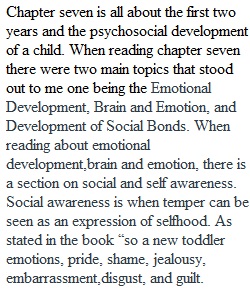


Q Response #5 Each week you will complete a response on Canvas and upload it before the start of the next class. The response will usually focus on that week's textbook reading. For full credit, responses should be approximately 500 words or the equivalent if you choose an optional format. Always include at least 2 citations to the text book using correct APA citation. Check citation on the Purdue OWL website: https://owl.purdue.edu/owl/research_and_citation/apa_style/apa_formatting_and_style_guide/in_text_citations_the_basics.html (Links to an external site.) The responses should be thoughtful, well-written, and demonstrate an understanding of the chapter. You will need to attach your document below to submit it. Prompts: Chapter 7 explores psychosocial development in the first 2 years. Some of the themes are Emotional Development, Brain and emotions, The Development of Social Bonds, Theories of Infant Psychosocial Development, Infant Child Care For this week you have 3 choices: 1. Write a 500 word response responding to 2 or 3 of the prompts below 2. Observe a child in this age group (birth- 24 months). You can observe a child you know or you can use a video, write up the observation. For both options you must include 2 citations. 3. Interview a parent of an infant or young toddler about their child's development in this area. You will need to come up with 5-7 interview questions based on the chapter. Interview: Prepare questions and interview a parent of an infant or toddler. You will need to come up with 5-7 interview questions based on the chapter. As an alternate to the interview, you can also focus on temperament with them and use the Georgetown temperament tool to learn more about the parent/ caregiver's temperament, child's temperament and suggestions for goodness of fit. https://www.ecmhc.org/temperament/ (Links to an external site.) Write up your findings and support with the text. Observation option: Observe for at least 10 minutes or if you are watching videos, watch about 10 minutes of video. What do you notice about the child or children's social-emotional development (a limited milestone list is found on p. 204 you can also use the CDC milestone lists - these are more comprehensive and useful - https://www.cdc.gov/ncbddd/actearly/milestones/index.html). How does the infant or toddler interact with their environment and caregiver if you are observing them with the caregiver? If you have the opportunity to speak with their caregiver, how does their child show emotions? How do they interact with familiar and unfamiliar adults? How do they react to other children? What do you notice about their temperament (pp. 210-213)? Prompts option: (Choose at least 2 categories) 1. Emotional Development, Brain and Emotions: Describe social and self awareness in infants and toddlers. How might this vary in different cultures? Infants go through stages of separation anxiety and stranger wariness. When does this happen and how might you explain it to a parent or caregiver? Describe Goodness of Fit. How can parents or caregivers support goodness of fit? 2. Development of Social Bonds: How might synchrony affect early emotional development? How might an infant demonstrate proximity-seeking and contact-maintaining behaviors? How can you support families in developing health attachments with their babies? 3. Theories of Infant Psychosocial Development: Different theories of psychosocial development are described in pp. 224-230. Choose a theory you find interesting and summarize. Using that theory, what are some suggestions you would make to a caregiver or parent on how they can facilitate healthy emotional development? 4. Infant Child Care: Every county or region in California has a resource and referral agency that helps families connect with childcare. Look of the resource and referral agency for your home county or for Sonoma County. Pretend you are a parent looking for childcare. What are the types of childcare in your community? Does the R & R give you tips on finding a high quality child care program? How much does full time infant care cost? What if you need help paying for childcare, What kind of information can you find? After doing this preliminary search, does childcare for infants and toddlers appear available and affordable in your area? Length: 500 words. Response score sheet Prompts - 9 Writing quality - 3 - Citation -include 2 citations of the text book AND includes the use of proper APA format. - 3 Total 15 Rubric Responses Responses Criteria Ratings Pts This criterion is linked to a Learning OutcomeDescription of criterion Response to prompts 9 to >0.0 pts Full Marks 0 pts No Marks 9 pts This criterion is linked to a Learning OutcomeWriting 3 to >0.0 pts Full Marks 0 pts No Marks 3 pts This criterion is linked to a Learning OutcomeCitation Includes 2 citations from text 3 to >0.0 pts Full Marks 0 pts No Marks 3 pts Total Points: 15 PreviousNext
View Related Questions